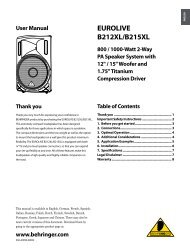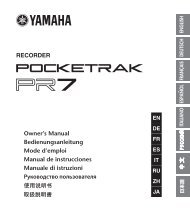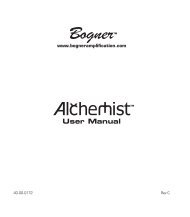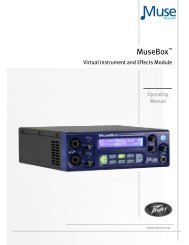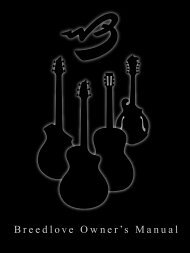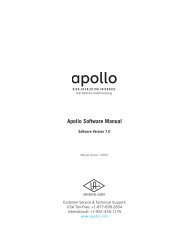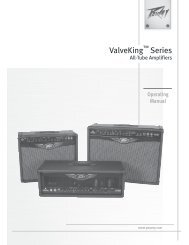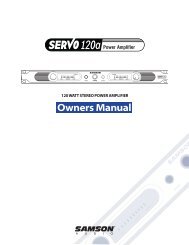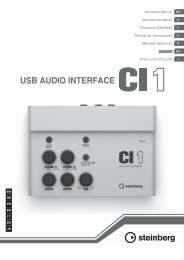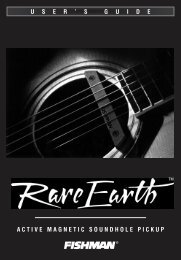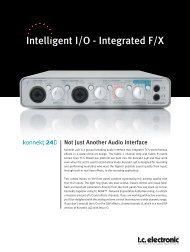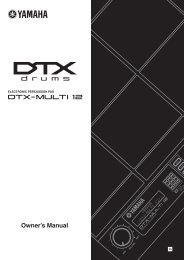SL 2 Manual for Serato Scratch Live 2.2.2 - zZounds.com
SL 2 Manual for Serato Scratch Live 2.2.2 - zZounds.com
SL 2 Manual for Serato Scratch Live 2.2.2 - zZounds.com
Create successful ePaper yourself
Turn your PDF publications into a flip-book with our unique Google optimized e-Paper software.
Calibrating<br />
<strong>Scratch</strong> <strong>Live</strong><br />
Since <strong>Scratch</strong> <strong>Live</strong> is controlled by an analog<br />
signal, there is no guarantee of what state that<br />
signal will be in by the time the software gets to<br />
interpret it. There<strong>for</strong>e, <strong>Scratch</strong> <strong>Live</strong> needs to be<br />
able to handle a wide range of signals, and be<br />
configurable to use them optimally. Calibrating<br />
is just configuring the software to your situation.<br />
Calibration is equally important <strong>for</strong> both vinyl<br />
and CD users of <strong>Scratch</strong> <strong>Live</strong>.<br />
There are two parts to the <strong>Scratch</strong> <strong>Live</strong> control<br />
signal: The directional tone, and the noise map.<br />
Listening to the control vinyl, the directional tone<br />
is the 1 kHz tone. The noise map sounds like<br />
random noise over the top of the tone.<br />
The directional tone provides the current<br />
speed and direction of the record, while the<br />
noise map tells the software precisely where on<br />
the record the needle is currently.<br />
The Noise Threshold<br />
A threshold is a lower limit, below which a<br />
process will not occur. In the case of <strong>Scratch</strong><br />
<strong>Live</strong>, the noise threshold is the limit below which<br />
the input signal will not be interpreted as control<br />
signal; in other words if it’s below the threshold,<br />
it is considered noise and ignored.<br />
This setting is necessary because a stylus is<br />
very sensitive, and will inevitably pick up noise<br />
from the environment as well as the signal on the<br />
record, especially in the noisy environment of a<br />
live show.<br />
How to Calibrate <strong>Scratch</strong> <strong>Live</strong><br />
With music playing in the background (from any<br />
source), put your needle on the record with the<br />
turntable stopped. If you are using CD players,<br />
the same rules apply. Have the CD deck paused<br />
or stopped while calibrating. Ensure the input<br />
level in <strong>Scratch</strong> <strong>Live</strong> is set correctly to accept a<br />
LINE level signal. See “Audio Input Level” on<br />
PAGE 32.<br />
Click and hold the estimate button until the<br />
slider stops moving. Moving the threshold slider<br />
to the left will make <strong>Scratch</strong> <strong>Live</strong> more sensitive<br />
to slow record movement, but also more<br />
sensitive to background noise.<br />
Repeat the process <strong>for</strong> each deck.<br />
Things to remember:<br />
• Your needle must be on the record.<br />
• Your turntable (or CD player) must be<br />
stationary.<br />
• The background music playing must be at a<br />
similar level to which you will play your set at.<br />
• Calibrate <strong>Scratch</strong> <strong>Live</strong> every time you play.<br />
TIP: If the slider jumps to the far right,<br />
then you have a problem with noise in your<br />
turntables/CD players/mixer. Check all your<br />
connections and make sure your equipment<br />
is well grounded. In some situations you will<br />
not be able to improve the signal quality, and<br />
you will have to play on regardless. In this<br />
situation, stick to REL mode.<br />
The Scopes<br />
The scopes on the Setup screen in <strong>Scratch</strong> <strong>Live</strong><br />
display the input signal as a phase diagram. The<br />
key factors to look at on the scope display are<br />
crisp clean lines, round shape, and the tracking<br />
percentage in the lower right corner.<br />
Start both turntables or CD players. You will<br />
see green rings appear in the scope view as<br />
shown here.<br />
For optimal per<strong>for</strong>mance the inner ring should<br />
be as close to circular as possible. Use the<br />
scope zoom slider (1x to 16x) to zoom in or out<br />
as necessary. Use the scope L/R Balance and<br />
P/A Balance controls to adjust the shape of the<br />
inner ring.<br />
The number in the top left corner of the scope<br />
view gives the current absolute position within<br />
the control record or CD. The number in the<br />
top right corner is the current speed in RPM. In<br />
the bottom left is the current threshold setting,<br />
and the number in the bottom right shows the<br />
percentage of readable signal – this number<br />
should be close to 85% when your system is<br />
calibrated properly.<br />
Calibration Troubleshooting<br />
After calibration, the number in the upper right<br />
corner of the scope view should say 0.0 while<br />
the needle is on the record and the turntable is<br />
stopped.<br />
If that number is fluctuating then manually<br />
move the Estimate slider to the right until that<br />
number is stable at 0.0. If you’ve moved the<br />
slider all the way to -24 and its still fluctuating<br />
then you have a grounding or interference<br />
problem somewhere in the chain.<br />
If so, the first thing to check is that the<br />
grounding wire <strong>com</strong>ing from your turntable is<br />
connected to either the <strong>SL</strong> 2’s or your mixer’s<br />
grounding posts.<br />
Next, make sure that the <strong>SL</strong> 2 isn’t sitting<br />
next to a power source such as a power strip or<br />
power box and that the RCA cables connected<br />
to the <strong>SL</strong> 2 aren’t laying across other power<br />
conducting cables.<br />
If you are still experiencing issues, you might<br />
have to adjust the placement of your setup. For<br />
example, make sure bass bins aren’t directly<br />
under the turntables. <strong>for</strong> more CALIBRATION<br />
troubleshooting help SEE “Scope Reading<br />
and Fixes” on page 38.<br />
RANE <strong>SL</strong> 2 FOR SERATO SCRATCH LIVE • OPERATOR’S MANUAL <strong>2.2.2</strong> 9



